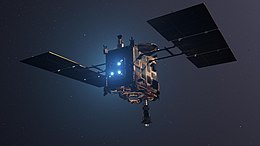Hayabusa 2
 | |
| Missiooni tüüp | Asteroidi pinnaseproovide Maale toomine |
|---|---|
| Operaator | JAXA |
| COSPAR ID | 2014-076A |
| SATCAT | 40319 |
| Kosmoseaparaadi omadused | |
| Tootja | NEC |
| Stardimass | 609 kg |
| Võimsus | 1.4 kW (1,4 aü) |
| Missiooni algus | |
| Stardi aeg | 04.22.00, 3. detsember 2014 (UTC) |
| Kanderakett | H-IIA |
| Stardikompleks | Yoshinobu stardikompleks, Tanegashima Kosmosekeskus |
|
| |
Hayabusa 2 (jaapani keeles はやぶさ2 'rabapistrik 2') on Jaapani kosmoseagentuuri JAXA kosmoseaparaat, mille eesmärk on uurida asteroidi 162173 Ryugu ja tuua sellelt Maale pinnaseproove.
Missioon startis 3. detsembril 2014 Tanegashima Kosmosekeskusest ja jõudis Ryugu orbiidile 27. juunil 2018.[1] Hayabusa 2 võttis Ryugult pinnaseproovid 21. veebruaril ja 5. aprillil 2019. Aparaat uuris Ryugut novembrini 2019 ja asus seejärel tagasiteele Maa suunas.[2] Kapsel pinnaseproovidega eraldus aparaadist 220 000 km kaugusel Maast ning see maandus 5. detsembril 2020 Austraalias Woomeras. Hayabusa 2 suundus uurima asteroidi 1998 KY26, mille juurde saabub 2031. aastal.[3][4]
Hayabusa 2 on edasiarendatud Hayabusast, mis uuris aastatel 2005-2007 asteroidi 25143 Itokawa.[5] 21. septembril 2018 eraldusid Hayabusa 2 küljest kaks kulgurit, mis maandusid edukalt Ryugu pinnale.[6]
Viited
[muuda | muuda lähteteksti]- ↑ "Imaging Ryugu from an altitude of 6km". JAXA Hayabusa 2 Project. Vaadatud 22. september 2018.
- ↑ "Hayabusa-2: Japan spacecraft leaves asteroid to head home". BBC News. Vaadatud 8. detsember 2020.
- ↑ "Hayabusa-2: Capsule with asteroid samples in 'perfect' shape". BBC News. Vaadatud 8. detsember 2020.
- ↑ "Japan's Hayabusa2 aims to probe asteroid "1998KY26" in 2031". Kyodo News. Vaadatud 8. detsember 2020.
- ↑ "Hayabusa". NASA. Vaadatud 2. oktoober 2018.
- ↑ "MINERVA-II1: Successful image capture, landing on Ryugu and hop!". JAXA Hayabusa 2 Project. Vaadatud 22. september 2018.
Text is available under the CC BY-SA 4.0 license; additional terms may apply.
Images, videos and audio are available under their respective licenses.
